Datasets
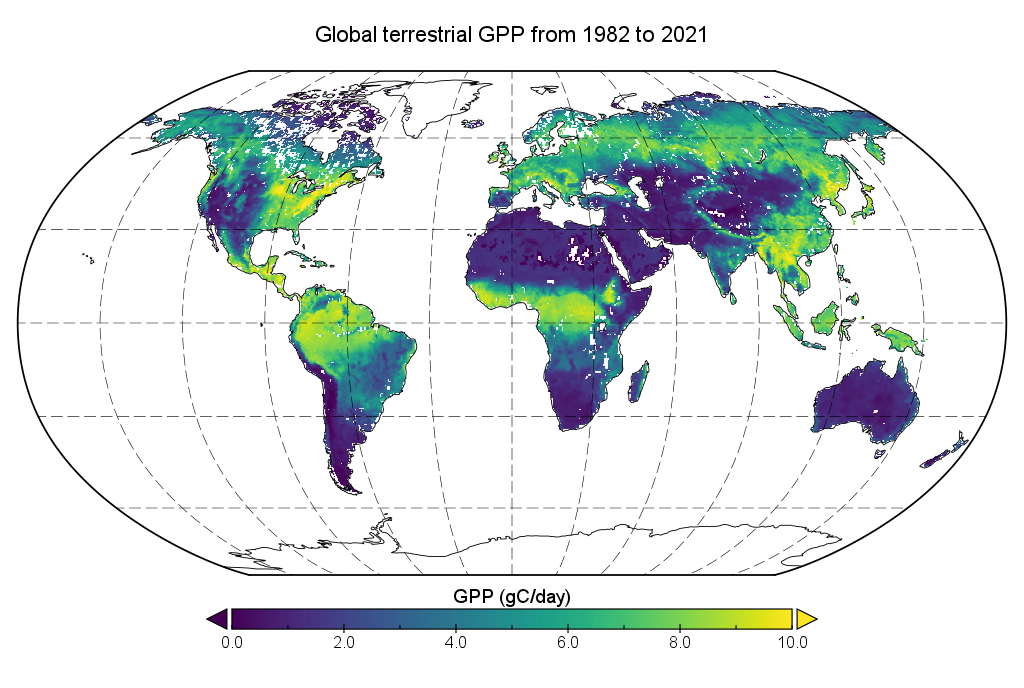
This dataset comprises a gridded time series of global terrestrial GPP product derived from four GPP datasets (EC-LUE, FLUXCOM, GOSIF, and VODCA2). The dataset was generated through a data processing procedure that included projection transformation, spatial resampling, interpolation, and maximum value composite (MVC) to generate a 0.5° resolution monthly product. The final value for each grid represents the ensemble mean of the four datasets.
| DATA DESCRIPTION | |
| Data type | Gridded |
| Projection | WGS 84 |
| Horizontal coverage | Global land |
| Horizontal resolution | 0.5° x 0.5° |
| Vertical coverage | Surface |
| Vertical resolution | Single level |
| Temporal coverage | From 2001 to 2016 |
| Temporal resolution | Monthly |
| File format | NetCDF4 |
| Key words | Gross Primary Productivity; Composite data |
| Versions | Version 1.0 |
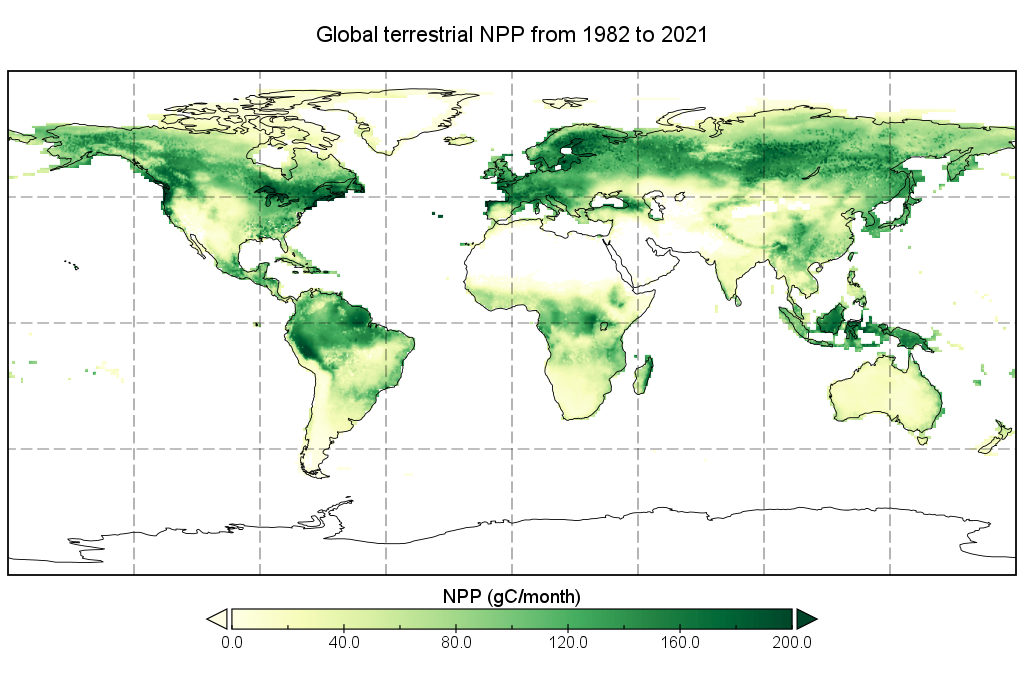
This dataset offers a gridded time series of global terrestrial NPP product derived from two distinct NPP datasets (GIMMS and MODIS). To generate this dataset, we employed a data processing procedure that included projection transformation, spatial resampling, interpolation, and MVC. This procedure helped us generate a monthly product at a resolution of 0.5°. The final value for each grid was calculated as the ensemble mean of the two datasets, ensuring maximum accuracy and reliability.
| DATA DESCRIPTION | |
| Data type | Gridded |
| Projection | WGS 84 |
| Horizontal coverage | Global land surface |
| Horizontal resolution | 0.5° x 0.5° |
| Vertical coverage | Surface |
| Vertical resolution | Single level |
| Temporal coverage | From 2001 to 2011 |
| Temporal resolution | Monthly |
| File format | NetCDF4 |
| Key words | Net Primary Productivity; Composite data |
| Versions | Version 1.0 |
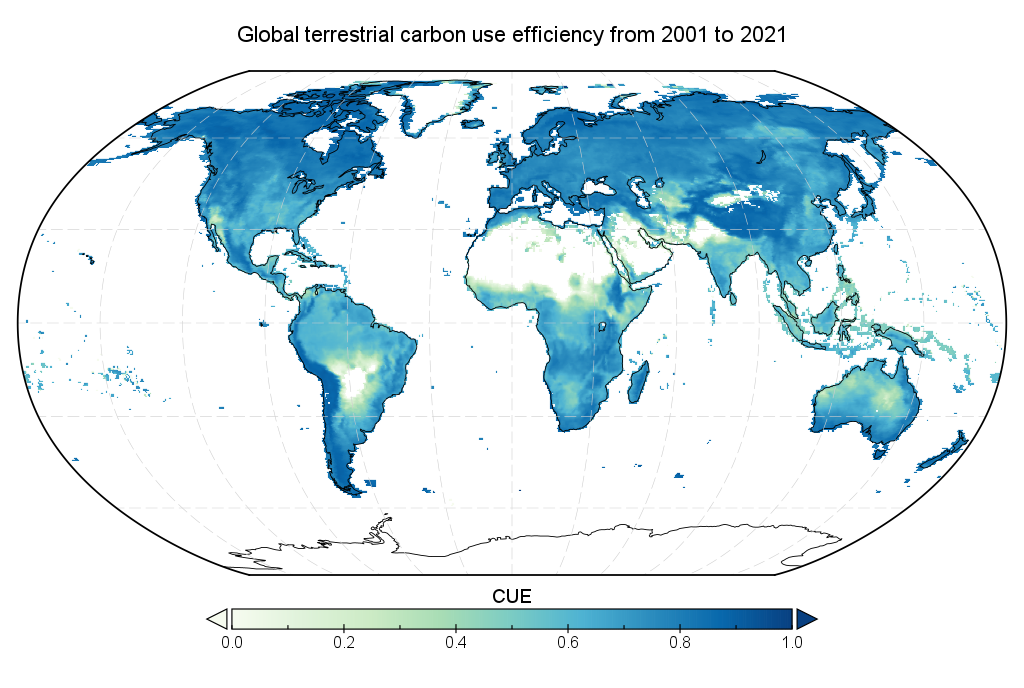
This dataset provides a gridded time series of global terrestrial carbon use efficiency (CUE) products, derived from MODIS gross primary productivity (GPP) and net primary productivity (NPP) datasets. We utilized a data processing procedure that included projection transformation, spatial resampling, interpolation, and MVC to generate a 0.5° resolution monthly product. The final value of each grid was the ratio of NPP to GPP.
| DATA DESCRIPTION | |
| Data type | Gridded |
| Projection | WGS 84 |
| Horizontal coverage | Global land surface |
| Horizontal resolution | 0.5° x 0.5° |
| Vertical coverage | Surface |
| Vertical resolution | Single level |
| Temporal coverage | From 2001 to 2021 |
| Temporal resolution | Monthly |
| File format | NetCDF4 |
| Key words | GPP; NPP; Carbon Use Efficiency |
| Versions | Version 1.0 |
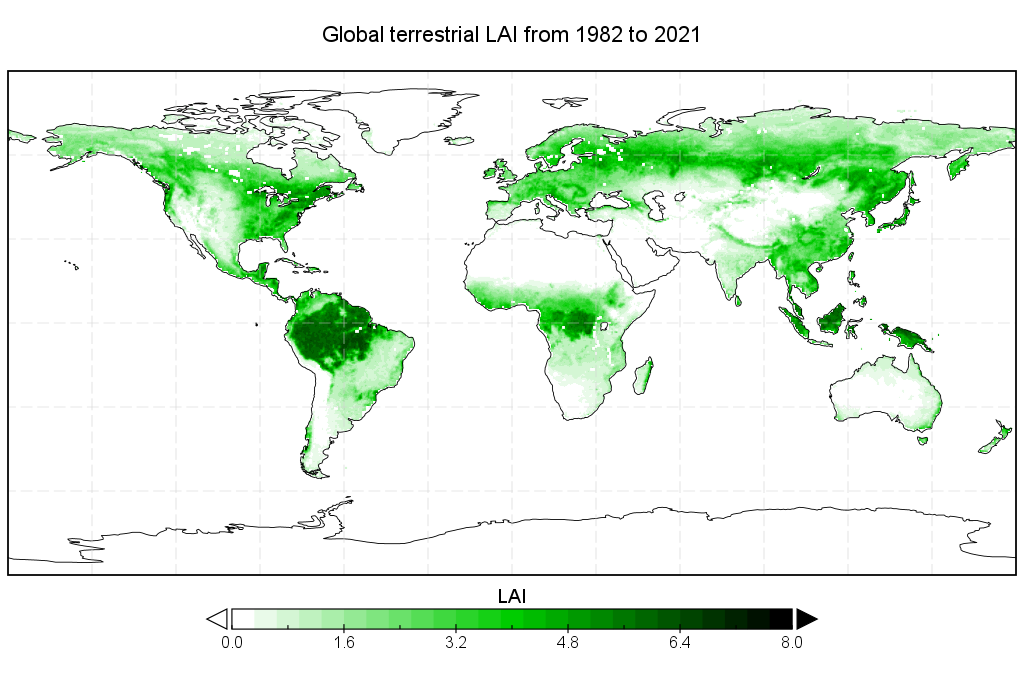
This dataset offers a gridded time series of global terrestrial LAI products, derived from four distinct datasets (GIMMS, GLASS, GLOBMAP, and MODIS). To generate this dataset, a data processing procedure was employed that involved projection transformation, spatial resampling, interpolation, and maximum value composite (MVC), resulting in a 0.5° resolution monthly product. The final value for each grid is the ensemble mean of the four datasets.
| DATA DESCRIPTION | |
| Data type | Gridded |
| Projection | WGS 84 |
| Horizontal coverage | Global land |
| Horizontal resolution | 0.5° x 0.5° |
| Vertical coverage | Top of the canopy |
| Vertical resolution | Single level |
| Temporal coverage | From 2001 to 2014 |
| Temporal resolution | Monthly |
| File format | NetCDF4 |
| Key words | Leaf Area Index; GIMMS LAI3g; GLASS; GLOBMAP; MODIS |
| Versions | Version 1.0 |
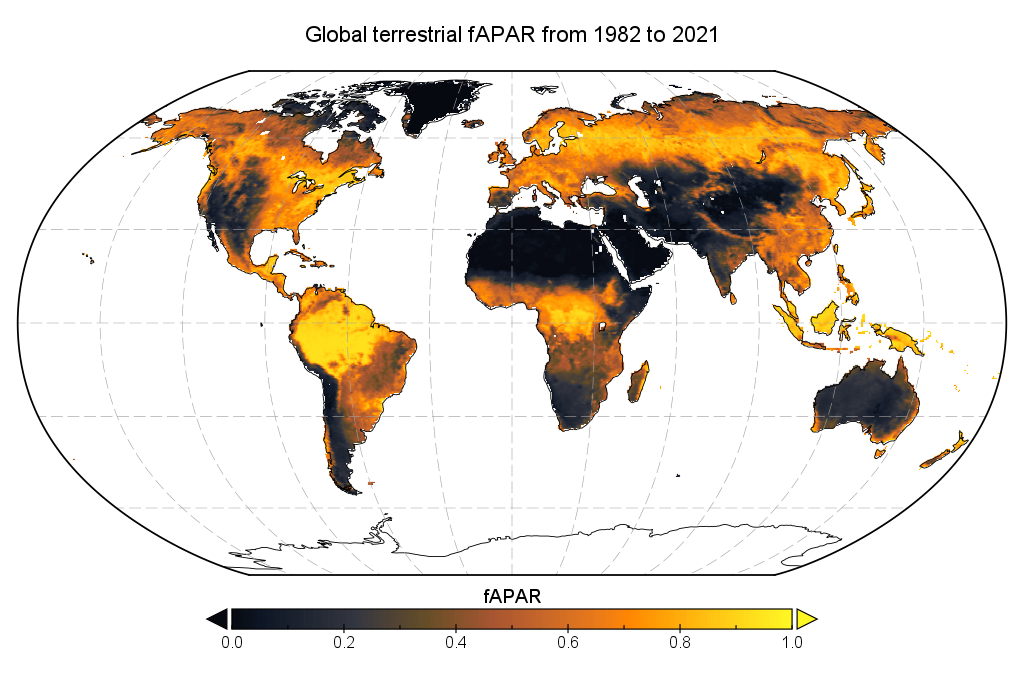
This dataset presents a gridded time series of global terrestrial fAPAR products, derived from three distinct datasets (GIMMS, GLASS, and MODIS). To generate this dataset, we used a data processing procedure that involved projection transformation, spatial resampling, interpolation, and maximum value composite (MVC), resulting in a monthly product at a 0.5° resolution. The final value for each grid is the ensemble mean of the three datasets.
| DATA DESCRIPTION | |
| Data type | Gridded |
| Projection | WGS 84 |
| Horizontal coverage | Global land |
| Horizontal resolution | 0.5° x 0.5° |
| Vertical coverage | Top of the canopy |
| Vertical resolution | Single level |
| Temporal coverage | From 2001 to 2016 |
| Temporal resolution | Monthly |
| File format | NetCDF4 |
| Key words | fraction of absorbed photosynthetically active radiation |
| Versions | version 1.0 |
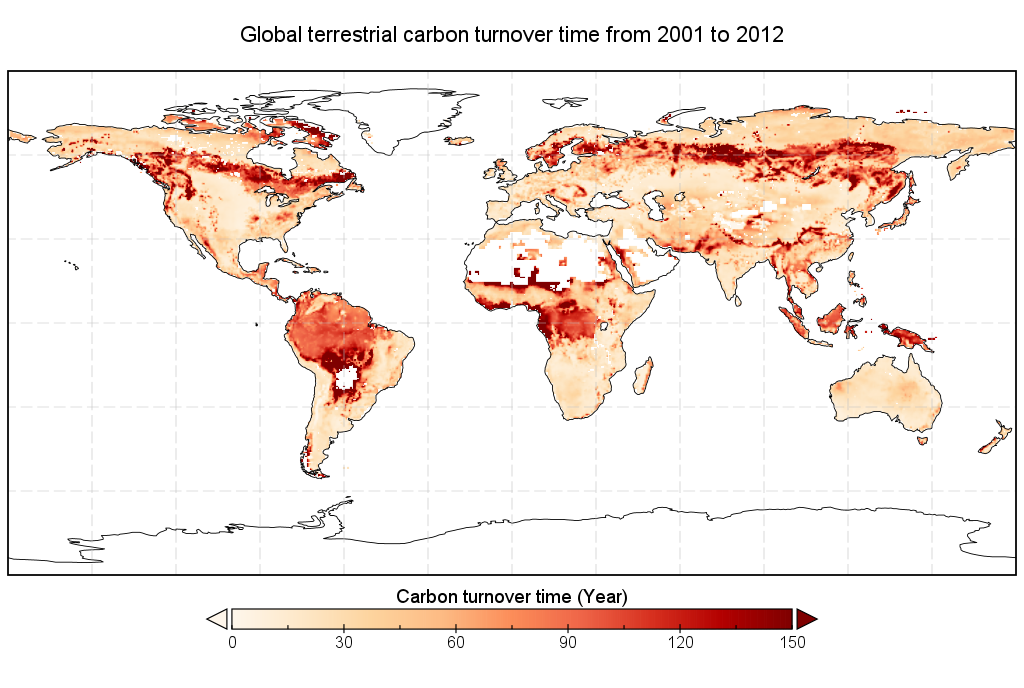
This dataset offers a gridded time series of global terrestrial carbon turnover time products derived from the MODIS net primary productivity (NPP) dataset and a global above-ground biomass (ABG) dataset estimated by Yi Y. Liu et al. To generate this dataset, we utilized a data processing procedure that included projection transformation, spatial resampling, interpolation, and MVC, resulting in a yearly product at a resolution of 0.5°. The final value of each grid was the ratio of ABG to NPP.
| DATA DESCRIPTION | |
| Data type | Gridded |
| Projection | WGS 84 |
| Horizontal coverage | Global land |
| Horizontal resolution | 0.5° x 0.5° |
| Vertical coverage | Surface |
| Vertical resolution | Single level |
| Temporal coverage | From 2001 to 2012 |
| Temporal resolution | Yearly |
| File format | NetCDF4 |
| Key words | Global above-ground carbon turnover time; NPP; |
| Versions | Version 1.0 |
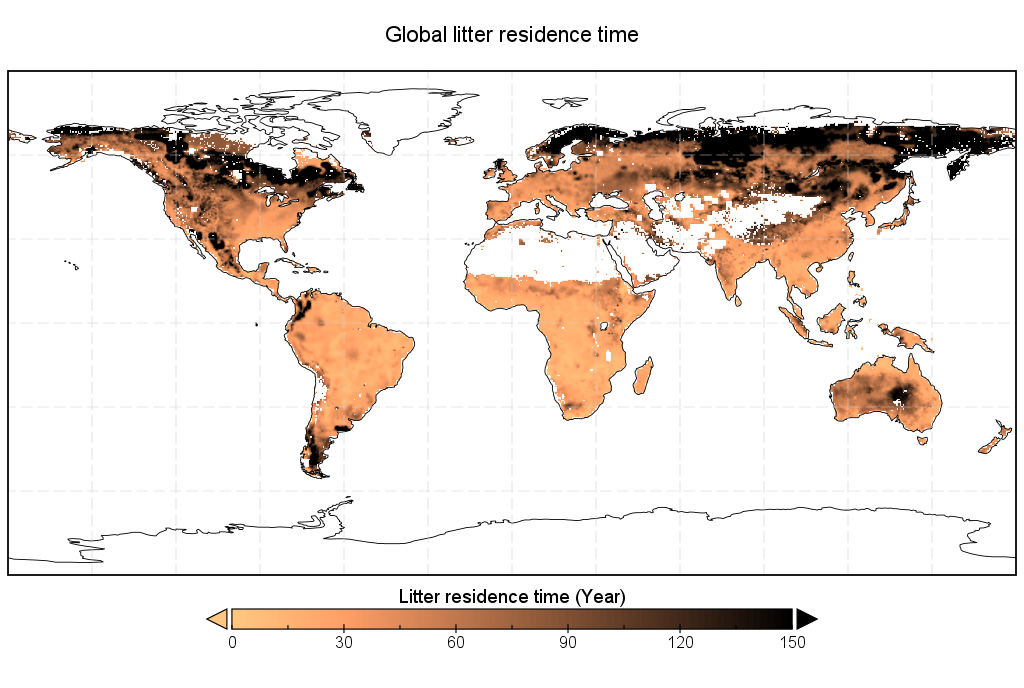
This dataset provides a gridded global terrestrial litter residence time product derived from Harmonized World Soil Database (HWSD) and global litter fall. To generate this dataset, we used a data processing procedure that included projection transformation, spatial resampling, interpolation, and MVC, resulting in a product at a 0.5° resolution. The final value for each grid was calculated using soil organic carbon pools and litter carbon flux, providing an estimate of the time taken for litter to decompose in a given area."
| DATA DESCRIPTION | |
| Data type | Gridded |
| Projection | WGS 84 |
| Horizontal coverage | Global land |
| Horizontal resolution | 0.5° x 0.5° |
| Vertical coverage | Surface |
| Vertical resolution | Single level |
| Temporal coverage | From 1955 to 2018 |
| Temporal resolution | Yearly |
| File format | NetCDF4 |
| Key words | HWSD; Litter fall; Litter residence time |
| Versions | Version 1.0 |
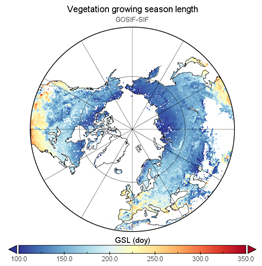
This dataset provides two gridded global terrestrial vegetation phenology product at a resolution of 0.5°. These datasets were derived from annual fraction of absorbed photosynthetically active radiation (GIMMS-fAPAR, 1982-2016) and solar-induced chlorophyll fluorescence (GOSIF-SIF, 2017-2021) time series data, respectively. To generate these datasets, each raster was first regressed using the least squares method of unary multiple to smooth and interpolate the time series of satellite data. The start and end dates of the growing season were then determined based on the time when the maximal and minimal changing rates occurred, providing an estimate of the timing of vegetation growth and senescence in a given area.
| DATA DESCRIPTION | |
| Data type | Gridded |
| Projection | GCS_WGS_1984 |
| Horizontal coverage | 60°N-90°N land |
| Horizontal resolution | 0.5° x 0.5° |
| Vertical coverage | Top of the canopy |
| Vertical resolution | Single level |
| Temporal coverage | From 1982 to 2016 for GIMMS-fAPAR; From 1917 to 2021 for GOSIF-SIF |
| Temporal resolution | Yearly |
| File format | NetCDF4 |
| Key words | GIMMS-fAPAR; vegetation growing season length |
| Versions | Present version is 1.0 |
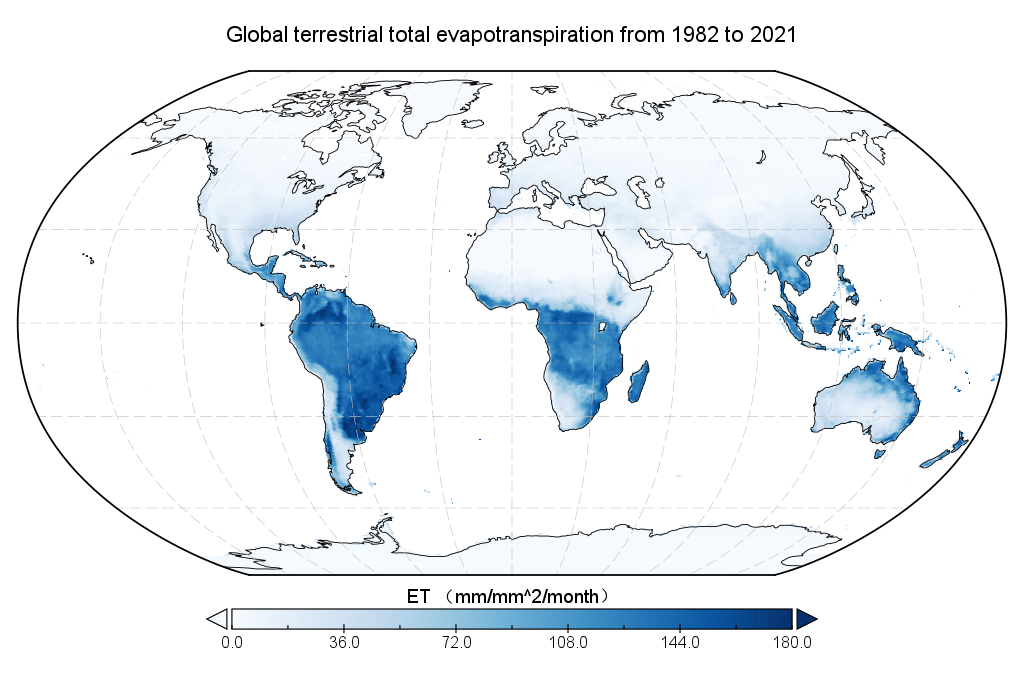
This dataset provides a gridded time series of global total terrestrial evapotranspiration products, derived from three datasets (GLEAMv3, FLUXCOM, and MODIS). The dataset was produced through a data processing procedure including projection transformation, spatial resampling, interpolation, and MVC to generate a 0.5° resolution yearly product. The final value for each grid is the ensemble mean of the three datasets, providing an estimate of the total amount of water lost through evaporation and transpiration from the land surface on an annual basis.
| DATA DESCRIPTION | |
| Data type | Gridded |
| Projection | WGS 84 |
| Horizontal coverage | Global land |
| Horizontal resolution | 0.5° x 0.5° |
| Vertical coverage | Integrated from surface to top of atmosphere |
| Vertical resolution | Single level |
| Temporal coverage | From 2001 to 2011 |
| Temporal resolution | Yearly |
| File format | NetCDF4 |
| Key words | GLobal evapotranspiration; GLEAMv3; FLUXCOM; MODIS |
| Versions | Version 1.0 |
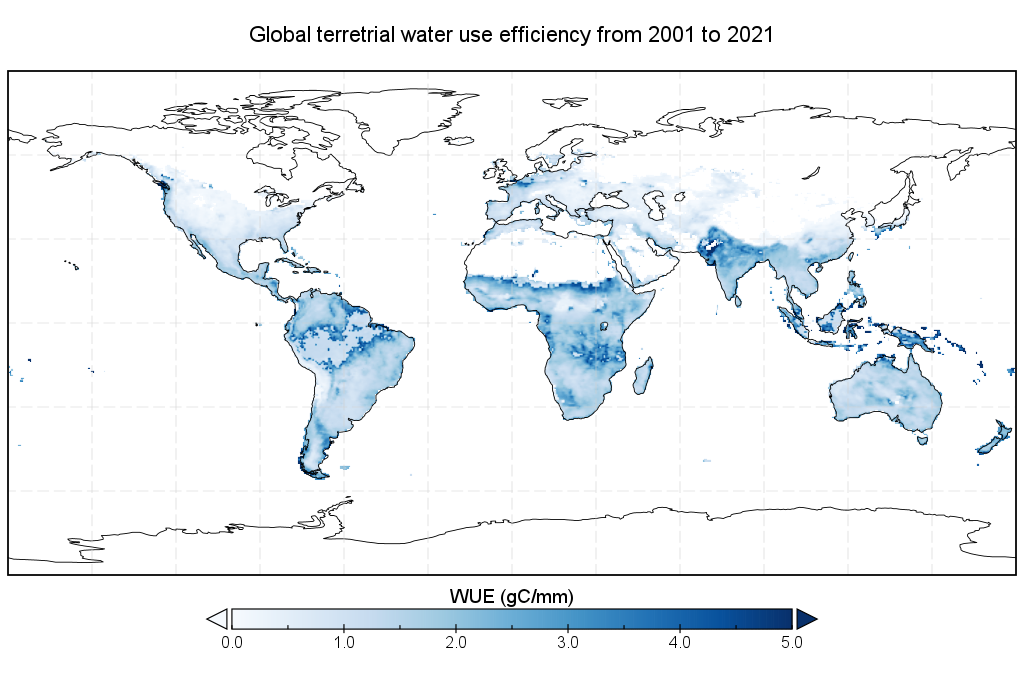
This dataset provides a gridded time series of global terrestrial water use efficiency products derived from MODIS GPP and ET datasets. The dataset was produced by dividing GPP by ET and processing through a procedure that included projection transformation, spatial resampling, interpolation, and MVC to generate a 0.5° resolution monthly product.
| DATA DESCRIPTION | |
| Data type | Gridded |
| Projection | WGS 84 |
| Horizontal coverage | Global land |
| Horizontal resolution | 0.5° x 0.5° |
| Vertical coverage | Surface |
| Vertical resolution | Single level |
| Temporal coverage | From 2001 to 2011 |
| Temporal resolution | Monthly |
| File format | NetCDF4 |
| Key words | Water use efficiency; GPP; ET |
| Versions | Version 1.0 |
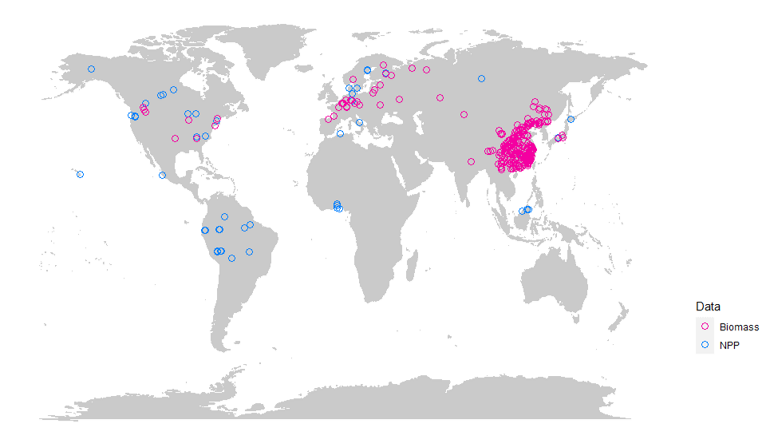
This dataset contains allocation coefficients of net primary productivity and biomass in major tree organs (roots, stems, leaves), as reported in published literature. The dataset mainly includes information on net primary productivity, biomass, allocation coefficients in roots, stems and leaves, and forest age. The data are drawn from various sites worldwide, covering a wide range of forest types and ages.
| DATA DESCRIPTION | |
| Data type | site observations |
| Horizontal coverage | Global |
| Temporal coverage | From 1975 to 2017 |
| File format | Excel |
| Key words | Biomass allocation coefficients; NPP allocation coefficients |
| Versions | Version 1.0 |
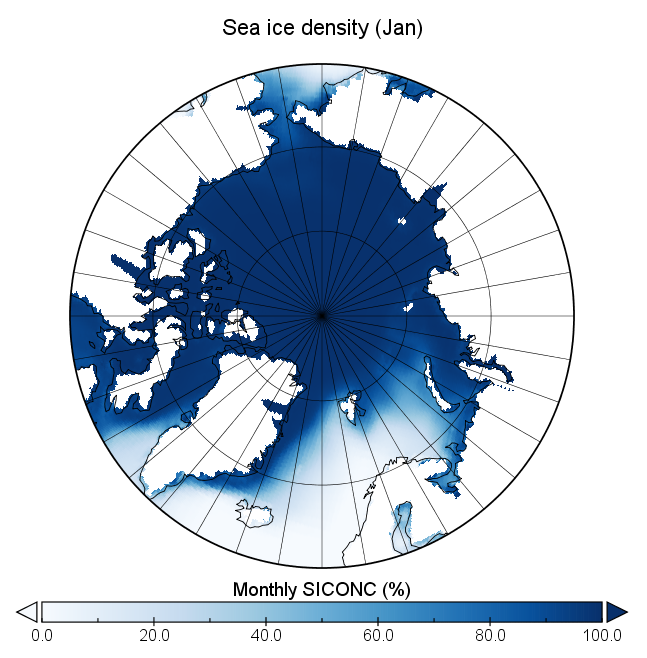
This dataset provides a gridded time series of Arctic sea ice concentration products derived from the sea ice concentration product (OSI-450) at the National Snow and Ice Data Center (NSIDC-0051). The dataset was produced through a data processing procedure including projection transformation, format conversion, accuracy conversion, grid processing, and averaging climate state processing to generate a 0.25° resolution monthly product.
| DATA DESCRIPTION | |
| Data type | Gridded |
| Projection | WGS 84 |
| Horizontal coverage | Arctic sea |
| Horizontal resolution | 0.25° x 0.25° |
| Temporal coverage | From 1980 to 2014 |
| Temporal resolution | Monthly |
| File format | NetCDF4 |
| Key words | Arctic sea ice |
| Versions | Version 1.0 |
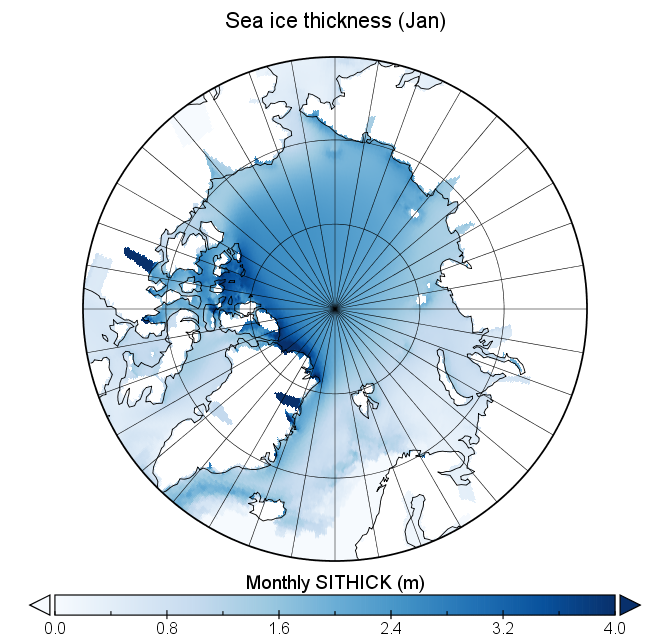
This dataset offers a gridded time series of Arctic sea ice thickness products that were derived from two sources of sea ice thickness observations, NSIDC-0746 and RDEFT4, both from the National Snow and Ice Data Center. The data underwent a series of processing steps, including projection transformation, format conversion, accuracy conversion, grid processing, and averaging climate state processing to generate a 0.25° resolution monthly product.
| DATA DESCRIPTION | |
| Data type | Gridded |
| Projection | WGS 84 |
| Horizontal coverage | Arctic sea |
| Horizontal resolution | 0.25° x 0.25° |
| Temporal coverage | From 1982 to 2014 |
| Temporal resolution | Monthly |
| File format | NetCDF4 |
| Key words | Arctic sea ice thickness |
| Versions | Version 1.0 |
The observational dataset of 25 kM Arctic surface net downward shortwave radiation from 1982 to 2014
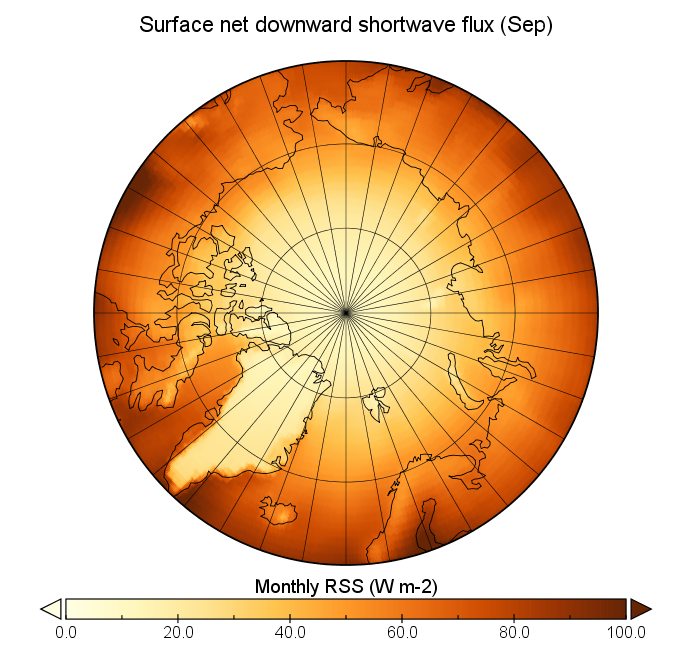
This dataset provides a gridded time series of Arctic surface net downward shortwave radiation observations, which were derived two sources of datasets: the Advanced Very High Resolution Radiometer post meridiem (AVHRR-PM) dataset and surface net downward shortwave radiation flux observations (NSIDC-0746) at the National Snow and Ice Data Center. The data underwent a processing procedure that included projection transformation, format conversion, accuracy conversion, grid processing, and averaging climate state processing. As a result, a monthly product with a resolution of 0.25° was generated.
| DATA DESCRIPTION | |
| Data type | Gridded |
| Projection | WGS 84 |
| Horizontal coverage | Arctic sea |
| Horizontal resolution | 0.25° x 0.25° |
| Temporal coverage | From 1982 to 2014 |
| Temporal resolution | Monthly |
| File format | NetCDF4 |
| Key words | Arctic surface net downward shortwave radiation |
| Versions | Version 1.0 |
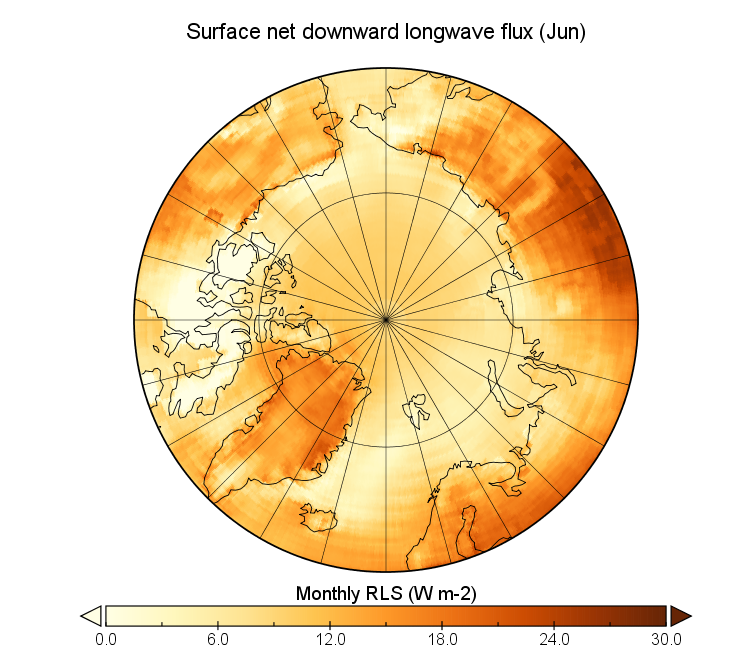
This dataset comprises a gridded time series of Arctic surface net downward longwave radiation flux products, which was derived from two sources: the Advanced Very High Resolution Radiometer post meridiem (AVHRR-PM) dataset and surface net downward longwave radiation flux observations (NSIDC-0746) at the National Snow Center. The dataset was produced through a data processing procedure including projection transformation, format conversion, accuracy conversion, grid processing, and averaging climate state processing to generate a monthly product with a resolution of 0.25°.
| DATA DESCRIPTION | |
| Data type | Gridded |
| Projection | WGS 84 |
| Horizontal coverage | Arctic sea |
| Horizontal resolution | 0.25° x 0.25° |
| Temporal coverage | From 1982 to 2014 |
| Temporal resolution | Monthly |
| File format | NetCDF4 |
| Key words | Arctic surface net downward longwave radiation |
| Versions | Version 1.0 |
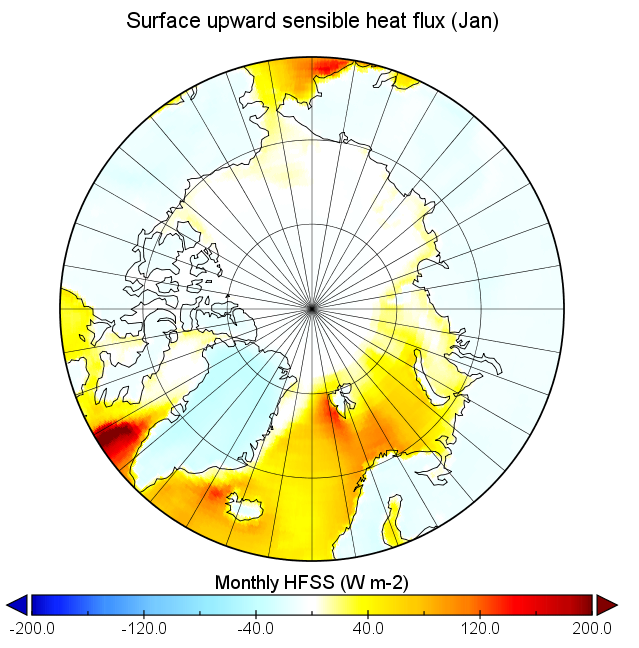
This dataset offers a gridded time series of Arctic surface sensible heat flux observations derived from two different datasets, namely the Modern-Era Retrospective analysis for Research and Applications-version 2 (MERRA-2-NASA) and the 5th major atmospheric reanalysis (ERA-5-ECMWF)). To create this dataset, a data processing procedure was implemented, including projection transformation, format conversion, accuracy conversion, grid processing, and averaging climate state processing. The end result is a monthly product with a resolution of 0.25°.
| DATA DESCRIPTION | |
| Data type | Gridded |
| Projection | WGS 84 |
| Horizontal coverage | Arctic sea |
| Horizontal resolution | 0.25° x 0.25° |
| Temporal coverage | From 1982 to 2014 |
| Temporal resolution | Monthly |
| File format | NetCDF4 |
| Key words | Arctic surface upward sensible heat flux |
| Versions | Version 1.0 |
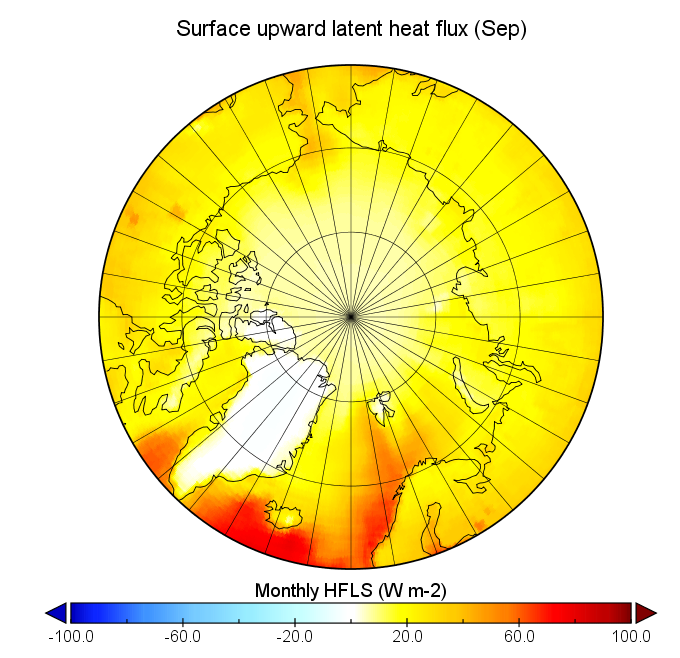
This dataset provides a gridded time series of Arctic surface latent heat flux observations, derived from two sources: the National Aeronautics and Space Administration Modern-Era Retrospective analysis for Research and Applications version 2 (MERRA-2) and the fifth generation of the European Centre for Medium-Range Weather Forecasts (ECMWF) atmospheric reanalyses (ERA5). The dataset was produced through a data processing procedure including projection transformation, format conversion, accuracy conversion, grid processing, and averaging climate state processing to generate a monthly product with a 0.25° resolution.
| DATA DESCRIPTION | |
| Data type | Gridded |
| Projection | WGS 84 |
| Horizontal coverage | Arctic sea |
| Horizontal resolution | 0.25° x 0.25° |
| Temporal coverage | From 1982 to 2014 |
| Temporal resolution | Monthly |
| File format | NetCDF4 |
| Key words | Arctic surface upward latent heat flux |
| Versions | Version 1.0 |
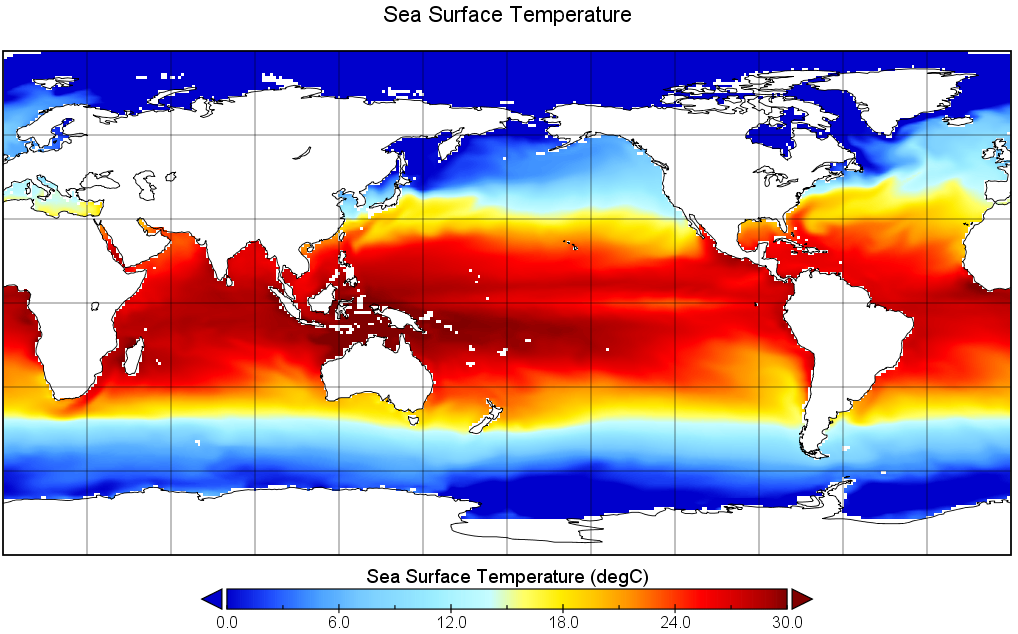
This dataset offered here contains a gridded time series of global sea surface temperature products, derived from sea surface temperature data (ERSST v5 and HadISST). The creation of this dataset involved several steps, such as projection transformation, format conversion, accuracy conversion, grid processing, and averaging climate state processing. The end result is a monthly product with a 0.25° resolution.
| DATA DESCRIPTION | |
| Data type | Gridded |
| Projection | WGS 84 |
| Horizontal coverage | Arctic sea |
| Horizontal resolution | 0.25° x 0.25° |
| Temporal coverage | From 1980 to 2014 |
| Temporal resolution | Monthly |
| File format | NetCDF4 |
| Key words | Global Sea Surface Temperature |
| Versions | Version 1.0 |
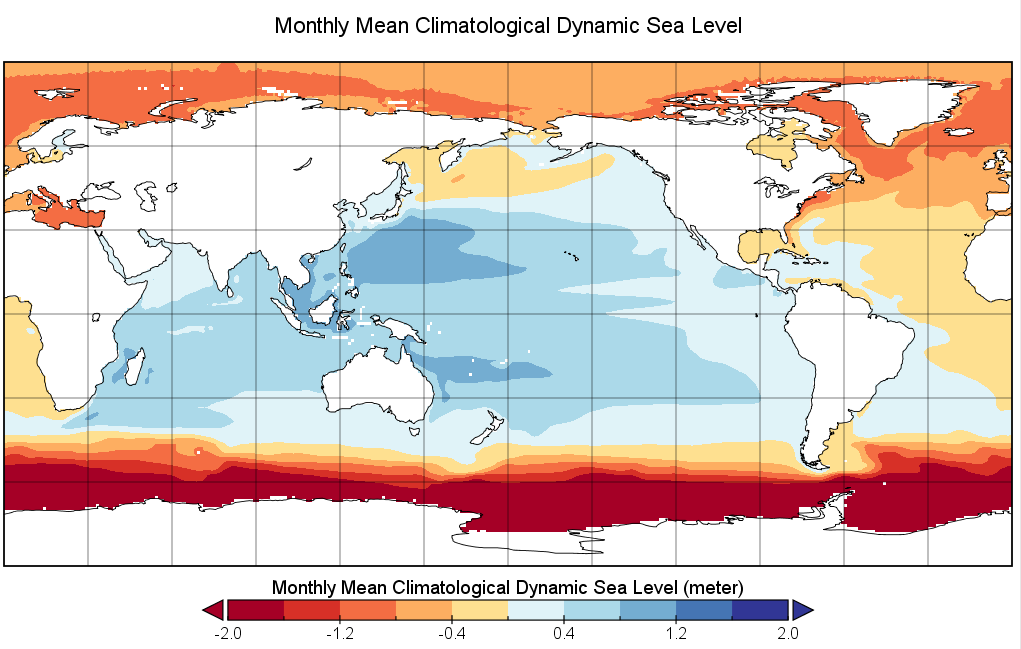
We produced a climatological dynamic sea level dataset by utilizing the original CMIP6 model data, which underwent interpolation and standardization to a uniform grid. The dataset was subsequently subjected to a comparison analysis with both altimeter data and the Ocean Reanalysis System 5 (ORAS5) dataset, utilizing a linear interpolation function at a spatial resolution of 1 degree and within a latitudinal-longitudinal range of 89.5°S-89.5°N and 0.5-359.5°E. This dataset is measured in meters and encompasses 40 sets of models featured in the CMIP6, alongside the multi-model ensemble (MME) and ORAS5 datasets for dynamic sea level. The ORAS5 reanalysis dataset is sourced from the European Centre for Medium-Range Weather Forecasts.
| DATA DESCRIPTION | |
| Data type | Gridded |
| Projection | WGS 84 |
| Horizontal coverage | Global Ocean |
| Horizontal resolution | 1° x 1° |
| Vertical coverage | surface |
| Temporal coverage | From 1993 to 2014 |
| Temporal resolution | Monthly |
| File format | NetCDF4 |
| Key words | Dynamic sea level; Comparison of models and ORAS5 dataset; |
| Versions | Version 1.0 |

The dynamic sea level dataset was generated by interpolating and standardizing the original CMIP5 model data onto a common grid, with a spatial resolution of 1 degree and a latitude-longitude range of 20°S-21°N and 120°E-281°E. The data is measured in meters and includes monthly dynamic sea level data from 20 sets of models in CMIP5, as well as the multi-model ensemble (MME) average data.
| DATA DESCRIPTION | |
| Data type | Gridded |
| Projection | WGS 84 |
| Horizontal coverage | 20°S-21°N, 120°E-281°E |
| Horizontal resolution | 1° x 1° |
| Vertical coverage | surface |
| Temporal coverage | From 1993 to 2005 |
| Temporal resolution | Monthly |
| File format | NetCDF4 |
| Key words | Dynamic sea level; CMIP5 model; multi-model ensemble (MME) average |
| Versions | Version 1.0 |

The dataset includes 12 models from CMIP6 and the halosteric sea level dataset of multi-model ensemble with BCC-CSM2-MR removed. The data was extracted for the Arctic region with latitude range of 60.5°N-89.5°N and longitude range of 0-360°E with a spatial resolution of 1° latitude by 1° longitude. The unit of data is centimeter (cm).
| DATA DESCRIPTION | |
| Data type | Gridded |
| Projection | WGS 84 |
| Horizontal coverage | Arctic region |
| Horizontal resolution | 1° x 1° |
| Vertical coverage | surface |
| Temporal coverage | From 1979 to 2014 |
| Temporal resolution | Monthly |
| File format | NetCDF4 |
| Key words | Halosteric sea level; difference between model and ORAS5; standard deviation; |
| Versions | Version 1.0 |

The dataset includes 12 models from CMIP6 and the thermosteric sea level dataset of multi-model ensemble with BCC-CSM2-MR removed. The data was extracted for the Arctic region with latitude range of 60.5°N-89.5°N and longitude range of 0-360°E with a spatial resolution of 1° latitude by 1° longitude. The unit of data is centimeter (cm).
| DATA DESCRIPTION | |
| Data type | Gridded |
| Projection | WGS 84 |
| Horizontal coverage | Arctic region |
| Horizontal resolution | 1° x 1° |
| Vertical coverage | surface |
| Temporal coverage | From 1979 to 2014 |
| Temporal resolution | Monthly |
| File format | NetCDF4 |
| Key words | Thermosteric sea level; difference between model and ORAS5; standard deviation; trend |
| Versions | Version 1.0 |

The dataset includes 12 models from CMIP6 and the total steric sea level dataset of multi-model ensemble with BCC-CSM2-MR removed. The data was extracted for the Arctic region with latitude range of 60.5°N-89.5°N and longitude range of 0-360°E with a spatial resolution of 1° latitude by 1° longitude. The unit of data is centimeter (cm).
| DATA DESCRIPTION | |
| Data type | Gridded |
| Projection | WGS 84 |
| Horizontal coverage | Arctic region |
| Horizontal resolution | 1° x 1° |
| Vertical coverage | surface |
| Temporal coverage | From 1979 to 2014 |
| Temporal resolution | Monthly |
| File format | NetCDF4 |
| Key words | Total steric sea level; difference between model and ORAS5; |
| Versions | Version 1.0 |

The dataset includes 12 models from CMIP6 and the total sea level dataset of multi-model ensemble with BCC-CSM2-MR removed. The data was extracted for the Arctic region with latitude range of 60.5°N-89.5°N and longitude range of 0-360°E with a spatial resolution of 1° latitude by 1° longitude. The unit of data is centimeter (cm).
| DATA DESCRIPTION | |
| Data type | Gridded |
| Projection | WGS 84 |
| Horizontal coverage | Arctic region |
| Horizontal resolution | 1° x 1° |
| Vertical coverage | surface |
| Temporal coverage | From 1979 to 2014 |
| Temporal resolution | Monthly |
| File format | NetCDF4 |
| Key words | Total sea level; difference between model and ORAS5; |
| Versions | Version 1.0 |

The dataset includes 12 models from CMIP6 and the mass sea level dataset of multi-model ensemble with BCC-CSM2-MR removed. The data was extracted for the Arctic region with latitude range of 60.5°N-89.5°N and longitude range of 0-360°E with a spatial resolution of 1° latitude by 1° longitude. The unit of data is centimeter (cm).
| DATA DESCRIPTION | |
| Data type | Gridded |
| Projection | WGS 84 |
| Horizontal coverage | Arctic region |
| Horizontal resolution | 1° x 1° |
| Vertical coverage | surface |
| Temporal coverage | From 1979 to 2014 |
| Temporal resolution | Monthly |
| File format | NetCDF4 |
| Key words | Mass sea level; difference between model and ORAS5; standard deviation; |
| Versions | Version 1.0 |

This dataset is composited with 20 CMIP6 models of sea surface water velocity (uo) data from 1980 to 2014. After projection conversion, interpolation, and grid data processing, the global grid product with a spatial resolution of 1 degree and a time resolution of 1 month is processed to form the final 1980-2014. The data unit is: m/s
| DATA DESCRIPTION | |
| Data type | Gridded |
| Projection | WGS 84 |
| Horizontal coverage | Ocean |
| Horizontal resolution | 1° x 1° |
| Vertical coverage | surface |
| Vertical resolution | Three level |
| Temporal coverage | From 1980 to 2014 |
| Temporal resolution | Monthly |
| File format | NetCDF4 |
| Key words | Mean Sea Surface Water Velocity; CMIP6 |
| Versions | Version 1.0 |

This dataset is composited with 20 CMIP6 models of sea surface water velocity. After projection conversion, interpolation, and grid data processing, the global grid product with a spatial resolution of 1 degree and a time resolution of one month is processed to form the final 1980-2014. The data unit is: m/s
| DATA DESCRIPTION | |
| Data type | Gridded |
| Projection | WGS 84 |
| Horizontal coverage | Ocean |
| Horizontal resolution | 1° x 1° |
| Vertical coverage | surface |
| Vertical coverage | Three level |
| Temporal coverage | From 1980 to 2014 |
| Temporal resolution | Monthly |
| File format | NetCDF4 |
| Key words | Mean Sea Surface Water Velocity |
| Versions | Version 1.0 |

This set of precipitation data is produced by Terra Climate Data, which uses climatically aided interpolation, combining high-spatial resolution climatological normals from the WorldClim dataset. The dataset was generated through a data processing procedure that included projection transformation, spatial resampling, interpolation, and sum value to generate a 0.5° resolution yearly product. The data at each grid represents a year's cumulative precipitation (mm).
| DATA DESCRIPTION | |
| Data type | Gridded |
| Projection | WGS 84 |
| Horizontal coverage | Global |
| Horizontal resolution | 0.5° x 0.5° |
| Temporal coverage | From 1982 to 2015 |
| Temporal resolution | Yearly |
| File format | NetCDF4 |
| Conventions | Terra Climate |
| Versions | Version 1.0 |
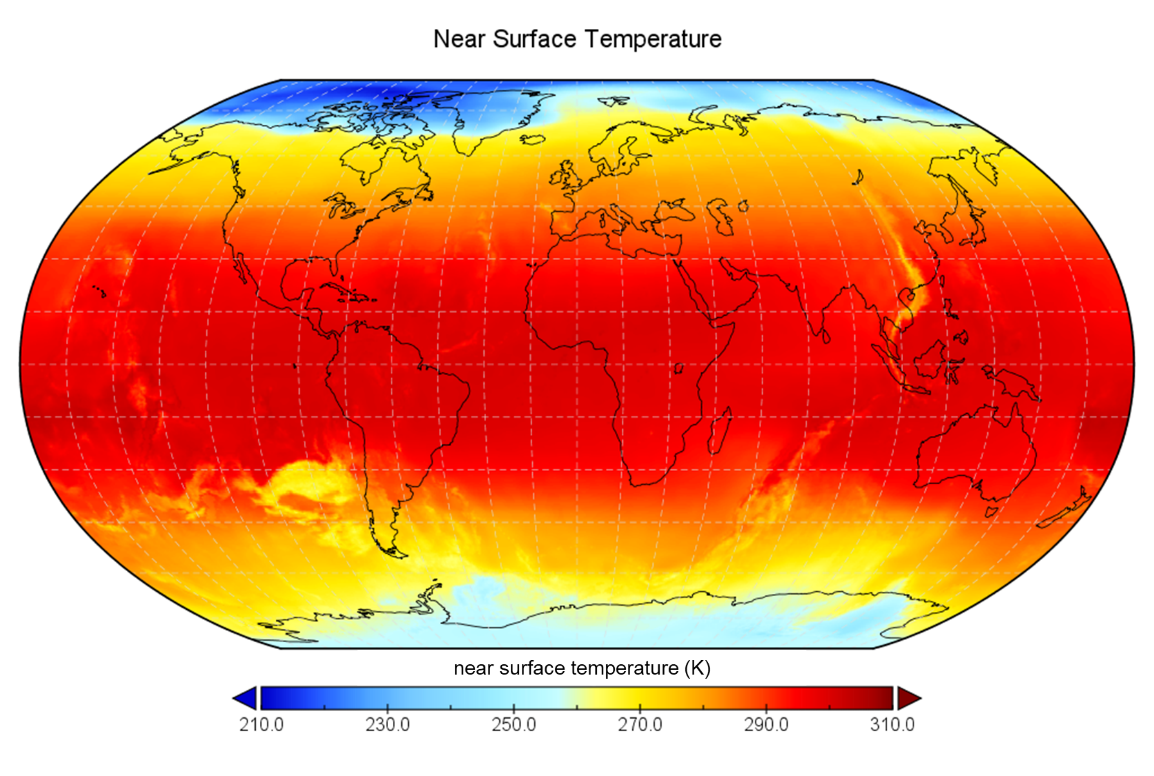
This set of temperature data is produced by MERRA-2 Data. The dataset was generated through a data processing procedure that included projection transformation, spatial resampling, interpolation, and mean value to generate a 0.5° resolution yearly product. The data at each grid represents a year's average temperature (K).
| DATA DESCRIPTION | |
| Data type | Gridded |
| Projection | WGS 84 |
| Horizontal coverage | Global |
| Horizontal resolution | 0.5° x 0.5° |
| Vertical coverage | Surface |
| Temporal coverage | From 1982 to 2021 |
| Temporal resolution | Yearly |
| File format | NetCDF4 |
| Conventions | MERRA-2 |
| Versions | Version 1.0 |
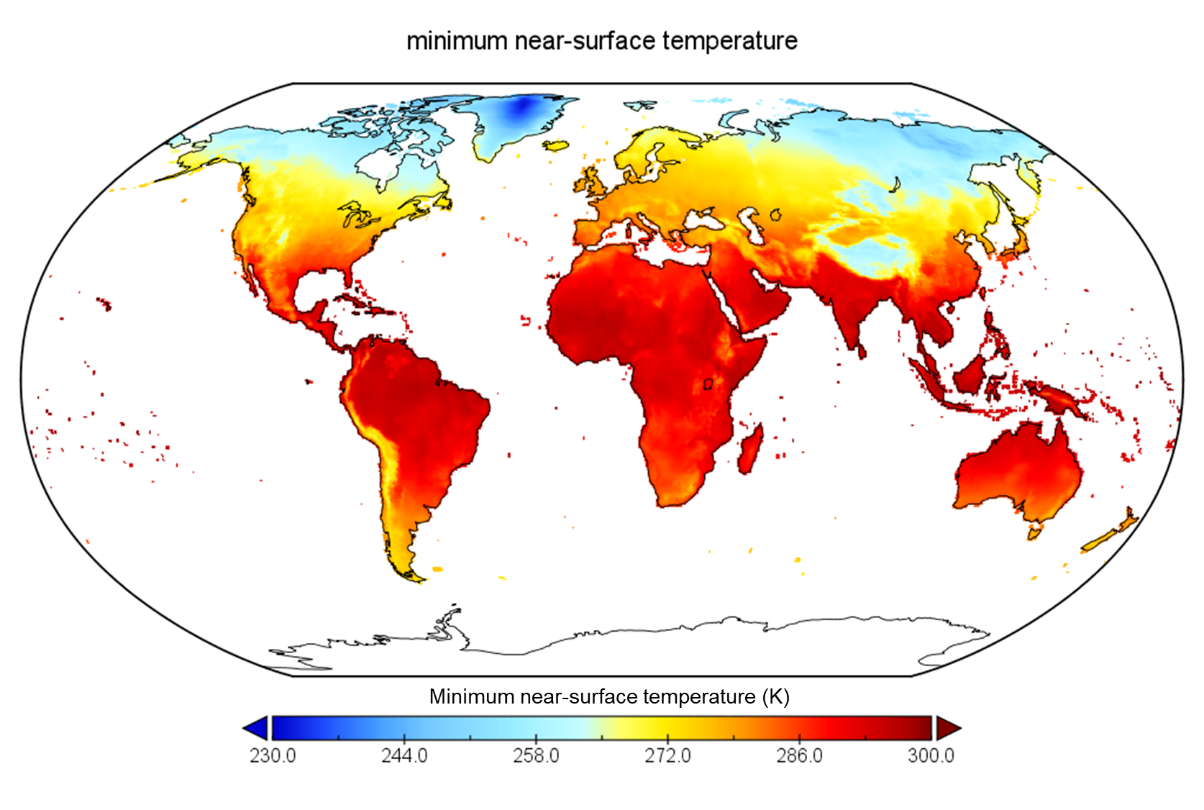
The CRU data are based on observations from weather stations around the world, which are interpolated to create a continuous grid of temperature values. The tasmin data provides monthly average values of the lowest temperature recorded during a 24-hour period at a spatial resolution of 0.5° latitude by 0.5° longitude. The unit of measurement for tasmin is degrees Celsius (°C).
| DATA DESCRIPTION | |
| Data type | Gridded |
| Projection | WGS 84 |
| Horizontal coverage | Global land |
| Horizontal resolution | 0.5° x 0.5° |
| Temporal coverage | From 1901 to 2021 |
| Temporal resolution | Monthly |
| File format | NetCDF4 |
| Versions | Version 1.0 |
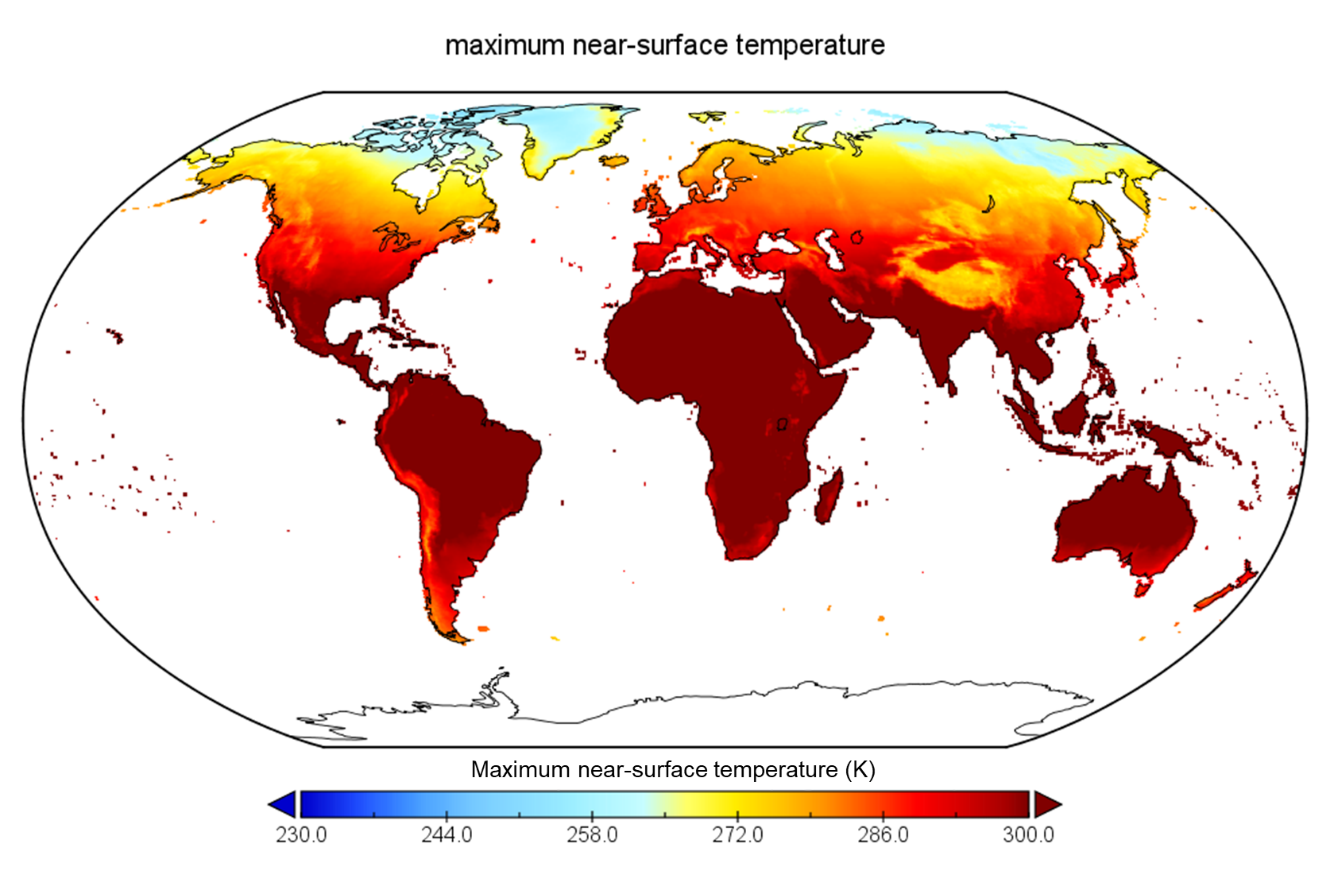
The CRU data are based on observations from weather stations around the world, which are interpolated to create a continuous grid of temperature values. The tasmax data provides monthly average values of the highest temperature recorded during a 24-hour period at a spatial resolution of 0.5° latitude by 0.5° longitude. The unit of measurement for tasmax is degrees Celsius (°C).
| DATA DESCRIPTION | |
| Data type | Gridded |
| Projection | WGS 84 |
| Horizontal coverage | Global land |
| Horizontal resolution | 0.5° x 0.5° |
| Temporal coverage | From 1901 to 2021 |
| Temporal resolution | Monthly |
| File format | NetCDF4 |
| Versions | Version 1.0 |

A climate state for the annual cycle of monthly mean geopotential height (unit: m) was constructed for all 12 months using the average values from 1950 to 1999, based on the historical experiments conducted using 40 models provided by CMIP6. The ensemble mean (MME) simulation of the climate state was obtained by simply averaging the results from the 40 models. All model data were interpolated to a resolution of 1° x 1°.
| DATA DESCRIPTION | |
| Data type | Gridded |
| Projection | WGS 84 |
| Horizontal coverage | Global |
| Horizontal resolution | 1° x 1° |
| Vertical coverage | Surface |
| Vertical resolution | Three level |
| Temporal coverage | From 1980 to 2015 |
| Temporal resolution | Monthly |
| File format | NetCDF4 |
| Versions | Version 1.0 |

Based on the historical simulation of 40 models provided by CMIP6 from 1950 to 1999, the monthly average sea level pressure (unit: hPa) of the 12 months of the year is constructed. An ensemble mean (MME) simulated climate state is given by a simple arithmetic mean of 40 models. Model data are all interpolated to 1° x 1° resolution.
| DATA DESCRIPTION | |
| Data type | Gridded |
| Projection | WGS 84 |
| Horizontal coverage | Global |
| Horizontal resolution | 1° x 1° |
| Vertical coverage | surface |
| Temporal coverage | From 1950 to 1999 |
| Temporal resolution | Monthly |
| File format | NetCDF4 |
| Key words | Air pressure at sea level |
| Versions | Version 1.0 |

This dataset is derived from the historical simulation of 40 CMIP6 models. An ensemble mean (MME) simulated climate state is given by a simple arithmetic mean of 40 models. The monthly eastward wind (unit: m/s) and the positive and negative values indicated south and north wind, respectively. All model data are interpolated to 1°x1° resolution.
| DATA DESCRIPTION | |
| Data type | Gridded |
| Projection | WGS 84 |
| Horizontal coverage | Near-surface land |
| Horizontal resolution | 1° x 1° |
| Vertical coverage | surface |
| Vertical resolution | three level |
| Temporal coverage | From 1950 to 1999 |
| Temporal resolution | Monthly |
| File format | NetCDF4 |
| Key words | Near-surface eastward wind |
| Versions | Version 1.0 |

This dataset is derived from the historical simulation of 40 CMIP6 models. An ensemble mean (MME) simulated climate state is given by a simple arithmeticaverage value of 40 models. The monthly northward wind (unit: m/s) and the positive and negative values indicated south and north wind, respectively. All model data are interpolated to 1°x1° resolution.
| DATA DESCRIPTION | |
| Data type | Gridded |
| Projection | WGS 84 |
| Horizontal coverage | Near-surface land |
| Horizontal resolution | 1° x 1° |
| Vertical coverage | surface |
| Vertical resolution | three level |
| Temporal coverage | From 1950 to 1999 |
| Temporal resolution | Monthly |
| File format | NetCDF4 |
| Key words | Near-surface northward wind |
| Versions | Version 1.0 |

A climate state for the annual cycle of monthly mean geopotential height (unit: m) was constructed for all 12 months using the average values from 2050 to 2099, based on the SSP2-4.5 conducted using 40 models provided by CMIP6. The ensemble mean (MME) simulation of the climate state was obtained by simply averaging the results from the 40 models. All model data were interpolated to a resolution of 1° x 1°.
| DATA DESCRIPTION | |
| Data type | Gridded |
| Projection | WGS 84 |
| Horizontal coverage | Global |
| Horizontal resolution | 1° x 1° |
| Vertical coverage | surface |
| Vertical resolution | Three level |
| Temporal coverage | From 2050 to 2099 |
| Temporal resolution | Monthly |
| File format | NetCDF4 |
| Key words | Mean geopotential height; CMIP6 |
| Versions | Version 1.0 |

A climate state for the annual cycle of monthly mean geopotential height (unit: m) was constructed for all 12 months using the average values from 2050 to 2099, based on the SSP2-8.5 conducted using 40 models provided by CMIP6. The ensemble mean (MME) simulation of the climate state was obtained by simply averaging the results from the 40 models. All model data were interpolated to a resolution of 1° x 1°.
| DATA DESCRIPTION | |
| Data type | Gridded |
| Projection | WGS 84 |
| Horizontal coverage | Global |
| Horizontal resolution | 1° x 1° |
| Vertical coverage | surface |
| Vertical resolution | Three level |
| Temporal coverage | From 2050 to 2099 |
| Temporal resolution | Monthly |
| File format | NetCDF4 |
| Key words | Mean geopotential height; CMIP6 |
| Versions | Version 1.0 |

Based on the historical simulation of 40 models provided by CMIP6, using the average value from 1950 to 1999, the monthly average surface latent heat flux (unit: W/m2) for 12 months. An ensemble mean (MME) simulated climate state is given by a simple arithmetic mean of 40 models. All model data are interpolated to 1° x 1° resolution.
| DATA DESCRIPTION | |
| Data type | Gridded |
| Projection | WGS 84 |
| Horizontal coverage | Global |
| Horizontal resolution | 1° x 1° |
| Vertical coverage | surface |
| Vertical resolution | single level |
| Temporal coverage | From 1950 to 1999 |
| Temporal resolution | Monthly |
| File format | NetCDF4 |
| Key words | Surface sensible heat flux; CMIP6 |
| Versions | Version 1.0 |

Based on the high-emission scenario prediction experiment (SSP2-4.5 experiment) of 40 models provided by CMIP6, using the average value from 2050 to 2099, the surface latent heat flux (unit: W/m2) for 12 months. An ensemble mean (MME) simulated climate state is given by a simple arithmetic mean of 40 models. All model data are interpolated to 1° x 1° resolution.
| DATA DESCRIPTION | |
| Data type | Gridded |
| Projection | WGS 84 |
| Horizontal coverage | Global |
| Horizontal resolution | 1° x 1° |
| Vertical coverage | surface |
| Vertical resolution | Single level |
| Temporal coverage | From 2050 to 2099 |
| Temporal resolution | Monthly |
| File format | NetCDF4 |
| Key words | Surface sensible heat flux; CMIP6 |
| Versions | Version 1.0 |

Based on the high-emission scenario prediction experiment (SSP5-8.5 experiment) of 40 models provided by CMIP6, using the average value from 2050 to 2099, the surface latent heat flux (unit: W/m2) for 12 months. An ensemble mean (MME) simulated climate state is given by a simple arithmetic mean of 40 models. All model data are interpolated to 1° x 1° resolution.
| DATA DESCRIPTION | |
| Data type | Gridded |
| Projection | WGS 84 |
| Horizontal coverage | Global |
| Horizontal resolution | 1° x 1° |
| Vertical coverage | surface |
| Vertical resolution | Single level |
| Temporal coverage | From 2050 to 2099 |
| Temporal resolution | Monthly |
| File format | NetCDF4 |
| Key words | Surface sensible heat flux; CMIP6 |
| Versions | Version 1.0 |

Based on the historical simulation experiment of 40 models provided by CMIP6, using the average value from 1950 to 1999, the monthly average precipitation rate (unit: mm/day) of the 12 months is constructed. An ensemble mean (MME) simulated climate state is given by a simple arithmetic mean of 40 models. All model data are interpolated to 1° x 1° resolution.
| DATA DESCRIPTION | |
| Data type | Gridded |
| Projection | WGS 84 |
| Horizontal coverage | Global |
| Horizontal resolution | 1° x 1° |
| Vertical coverage | surface |
| Vertical resolution | Single level |
| Temporal coverage | From 1950 to 1999 |
| Temporal resolution | Monthly |
| File format | NetCDF4 |
| Key words | The precipitation rate; CMIP6 |
| Versions | Version 1.0 |

Based on the medium-emission scenario prediction (SSP2-4.5) of 40 models provided by CMIP6, using the average value from 2050 to 2099, the annual 12-month precipitation rate (unit: mm/day) was constructed. An ensemble mean (MME) simulated climate state is given by a simple arithmetic mean of 40 models. All model data are interpolated to 1° x 1° resolution.
| DATA DESCRIPTION | |
| Data type | Gridded |
| Projection | WGS 84 |
| Horizontal coverage | Global |
| Horizontal resolution | 1° x 1° |
| Vertical coverage | surface |
| Vertical resolution | Single level |
| Temporal coverage | From 2050 to 2099 |
| Temporal resolution | Monthly |
| File format | NetCDF4 |
| Key words | The precipitation rate; CMIP6 |
| Versions | Version 1.0 |

Based on the high-emission scenario prediction (SSP5-8.5) of 40 models provided by CMIP6, using the average value from 2050 to 2099, the annual 12-month precipitation rate (unit: mm/day) was constructed. An ensemble mean (MME) simulated climate state is given by a simple arithmetic mean of 40 models. All model data are interpolated to 1° x 1° resolution.
| DATA DESCRIPTION | |
| Data type | Gridded |
| Projection | WGS 84 |
| Horizontal coverage | Global |
| Horizontal resolution | 1° x 1° |
| Vertical coverage | surface |
| Vertical resolution | Single level |
| Temporal coverage | From 2050 to 2099 |
| Temporal resolution | Monthly |
| File format | NetCDF4 |
| Key words | The precipitation rate; CMIP6 |
| Versions | Version 1.0 |

Based on the historical simulation of 40 models provided by CMIP6, using the average value from 1950 to 1999, the interannual variability of surface air temperature (unit: K) was constructed for 12 months of the year. An ensemble mean (MME) simulated climate state is given by a simple arithmetic mean of 40 models. All model data are interpolated to 1° x 1° resolution.
| DATA DESCRIPTION | |
| Data type | Gridded |
| Projection | WGS 84 |
| Horizontal coverage | Global |
| Horizontal resolution | 1° x 1° |
| Vertical coverage | surface |
| Vertical resolution | Single level |
| Temporal coverage | From 1980 to 2015 |
| Temporal resolution | Monthly |
| File format | NetCDF4 |
| Key words | The surface air temperature; CMIP6 |
| Versions | Version 1.0 |

Based on the high-emission scenario prediction (SSP5-8.5 scenarios) of 40 models provided by CMIP6, using the average value from 2050 to 2099, the interannual variability of surface air temperature (unit: K) for 12 months of the year was constructed. An ensemble mean (MME) simulated climate state is given by a simple arithmetic mean of 40 models. All model data are interpolated to 1° x 1° resolution.
| DATA DESCRIPTION | |
| Data type | Gridded |
| Projection | WGS 84 |
| Horizontal coverage | Global |
| Horizontal resolution | 1° x 1° |
| Vertical coverage | surface |
| Vertical resolution | Single level |
| Temporal coverage | From 2050 to 2099 |
| Temporal resolution | Monthly |
| File format | NetCDF4 |
| Key words | The surface air temperature; CMIP6 |
| Versions | Version 1.0 |

Based on the high-emission scenario prediction (SSP5-8.5 scenarios) of 40 models provided by CMIP6, using the average value from 2050 to 2099, the interannual variability of surface air temperature (unit: K) for 12 months of the year was constructed. An ensemble mean (MME) simulated climate state is given by a simple arithmetic mean of 40 models. All model data are interpolated to 1° x 1° resolution.
| DATA DESCRIPTION | |
| Data type | Gridded |
| Projection | WGS 84 |
| Horizontal coverage | Global |
| Horizontal resolution | 1° x 1° |
| Vertical coverage | surface |
| Vertical resolution | Single level |
| Temporal coverage | From 2050 to 2099 |
| Temporal resolution | Monthly |
| File format | NetCDF4 |
| Key words | The surface temperature; CMIP6 |
| Versions | Version 1.0 |

Based on the historical climate simulation experiments provided by 40 CMIP6 models, using the average from 1950 to 1999, we constructed an annual cycle of monthly mean surface sensible heat flux (measured in W/m2) for all 12 months. The data from all models were interpolated to a spatial resolution of 1° x 1°. The ensemble mean (MME) of the simulation was obtained by a simple arithmetic mean of the 40 models.
| DATA DESCRIPTION | |
| Data type | Gridded |
| Projection | WGS 84 |
| Horizontal coverage | Global |
| Horizontal resolution | 1° x 1° |
| Vertical coverage | surface |
| Vertical resolution | Three level |
| Temporal coverage | From 1950 to 1999 |
| Temporal resolution | Monthly |
| File format | NetCDF4 |
| Key words | Surface sensible heat flux; historical simulation experiment; global gridded data. |
| Versions | Version 1.0 |

Based on the SSP2-4.5 scenario experiment from 40 models provided by CMIP6, the climatological annual cycle of surface sensible heat flux (unit: W/m2) for 12 months was constructed using the average value from 2050 to 2099. All model data was interpolated to a resolution of 1°x1°. The ensemble average (MME) of simulations was derived from a simple arithmetic average of 40 models.
| DATA DESCRIPTION | |
| Data type | Gridded |
| Projection | WGS 84 |
| Horizontal coverage | Global |
| Horizontal resolution | 1° x 1° |
| Vertical coverage | surface |
| Vertical resolution | Three level |
| Temporal coverage | From 2050 to 2099 |
| Temporal resolution | Monthly |
| File format | NetCDF4 |
| Key words | Surface sensible heat flux; SSP2-4.5 scenario; global grid data |
| Versions | Version 1.0 |

Based on the high-emission scenario projection experiment (SSP5-8.5) of 40 models provided by CMIP6, the annual cycle of surface sensible heat flux (unit: W/m2) for all 12 months was constructed using the average value from 2050 to 2099, and all model data were interpolated to a resolution of 1°×1°. The climate state of the ensemble average (MME) simulation is given by a simple arithmetic average of the 40 models.
| DATA DESCRIPTION | |
| Data type | Gridded |
| Projection | WGS 84 |
| Horizontal coverage | Global |
| Horizontal resolution | 1° x 1° |
| Vertical coverage | surface |
| Vertical resolution | Three level |
| Temporal coverage | From 2050 to 2099 |
| Temporal resolution | Monthly |
| File format | NetCDF4 |
| Key words | Surface sensible heat flux; High-emission scenario; Global grid data |
| Versions | Version 1.0 |

Based on the SSP2-4.5 of 40 models provided by CMIP6 from 2050 to 2099, the monthly average sea level pressure (unit: hPa) of the 12 months of the year is constructed. An ensemble mean (MME) simulated climate state is given by a simple arithmetic mean of 40 models. Model data are all interpolated to 1° x 1° resolution.
| DATA DESCRIPTION | |
| Data type | Gridded |
| Projection | WGS 84 |
| Horizontal coverage | Global |
| Horizontal resolution | 1° x 1° |
| Vertical coverage | surface |
| Vertical resolution | Single level |
| Temporal coverage | From 2050 to 2099 |
| Temporal resolution | Monthly |
| File format | NetCDF4 |
| Key words | Air pressure at sea level; SSP2-8.5 emission scenario; CMIP6 |
| Versions | Version 1.0 |

Based on the SSP5-8.5 of 40 models provided by CMIP6 from 2050 to 2099, the monthly average sea level pressure (unit: hPa) of the 12 months of the year is constructed. An ensemble mean (MME) simulated climate state is given by a simple arithmetic mean of 40 models. Model data are all interpolated to 1° x 1° resolution.
| DATA DESCRIPTION | |
| Data type | Gridded |
| Projection | WGS 84 |
| Horizontal coverage | Global |
| Horizontal resolution | 1° x 1° |
| Vertical coverage | surface |
| Vertical resolution | Single level |
| Temporal coverage | From 2050 to 2099 |
| Temporal resolution | Monthly |
| File format | NetCDF4 |
| Key words | Air pressure at sea level; SSP2-4.5 emission scenario; CMIP6 |
| Versions | Version 1.0 |

This dataset is composited with 20 CMIP6 models of near-surface wind from 2055 to 2099. After projection conversion, interpolation, and grid data processing, the global grid product with a spatial resolution of 1 degree and a time resolution of 1 month is processed to form the final 2055-2099. The data unit is: m/s
| DATA DESCRIPTION | |
| Data type | Gridded |
| Projection | WGS 84 |
| Horizontal coverage | Global |
| Horizontal resolution | 1° x 1° |
| Vertical coverage | surface |
| Vertical resolution | Three level |
| Temporal coverage | From 2050 to 2099 |
| Temporal resolution | Monthly |
| File format | NetCDF4 |
| Key words | Near-surface northward wind; CMIP6 |
| Versions | Version 1.0 |

This dataset is composited with 20 CMIP6 surface northward wind velocities. After projection conversion, interpolation, and grid data processing, the global grid product with a spatial resolution of 1 degree and a time resolution of one month is processed to form the final 2055-2099. The data unit is: m/s
| DATA DESCRIPTION | |
| Data type | Gridded |
| Projection | WGS 84 |
| Horizontal coverage | Global |
| Horizontal resolution | 1° x 1° |
| Vertical coverage | surface |
| Vertical resolution | Three level |
| Temporal coverage | From 2055 to 2099 |
| Temporal resolution | Monthly |
| File format | NetCDF4 |
| Key words | Near-surface northward wind; CMIP6 |
| Versions | Version 1.0 |

This dataset is derived from the SSP2-4.5 medium emission scenarios simulation of 40 CMIP6 models from 2055 to 2099. An ensemble mean (MME) simulated climate state is given by a simple arithmetic mean of 40 models. The monthly eastward wind (unit: m/s) and the positive and negative values indicated south and north wind, respectively. All model data are interpolated to 1° x 1° resolution.
| DATA DESCRIPTION | |
| Data type | Gridded |
| Projection | WGS 84 |
| Horizontal coverage | Global |
| Horizontal resolution | 1° x 1° |
| Vertical coverage | surface |
| Vertical resolution | Three level |
| Temporal coverage | From 2055 to 2099 |
| Temporal resolution | Monthly |
| File format | NetCDF4 |
| Key words | Near-surface eastward wind; CMIP6 |
| Versions | Version 1.0 |

Based on the high-emission scenario projection experiments (SSP5-8.5) provided by 40 models in CMIP6, a climatological annual cycle of Northward wind (in m/s, positive values represent southerly winds, and negative values represent northerly winds) for all 12 months was constructed using the average values from 2050 to 2099. All model data were interpolated to a resolution of 1° × 1°. The climate state of the multi-model ensemble (MME) simulation was obtained by taking the simple arithmetic mean of the 40 models.
| DATA DESCRIPTION | |
| Data type | Gridded |
| Projection | WGS 84 |
| Horizontal coverage | Global |
| Horizontal resolution | 1° x 1° |
| Vertical coverage | surface |
| Vertical resolution | Three level |
| Temporal coverage | From 2050 to 2099 |
| Temporal resolution | Monthly |
| File format | NetCDF4 |
| Key words | Northward wind; High-emission scenario; CMIP6 |
| Versions | Version 1.0 |
